An Object-Based Approach to Map Young Forest and Shrubland Vegetation Based on Multi-Source Remote Sensing Data
Abstract
:1. Introduction
2. Materials and Methods
2.1. Study Area
2.2. Definitions of Vegetation Types
2.3. Segmentation, Pre-Classification, and Interpretation
2.3.1. Remotely Sensed Data
2.3.2. Preliminary Vegetation Classification
2.3.3. Interpretation and Review
2.4. Field Verification and Accuracy Assessment of Vegetation Classification
2.4.1. Sample Design, Sample Size, and Allocation to Strata
2.4.2. Response Design with Field and Digital Reference Data
2.4.3. Accuracy Assessment Analysis
3. Results
3.1. Young Forest and Shrubland Vegetation
3.1.1. Statewide
3.1.2. Accuracy Assessment
3.2. New England Cottontail Focus Areas
3.3. American Woodcock Focus Area
4. Discussion
5. Conclusions
Supplementary Materials
Author Contributions
Funding
Data Availability Statement
Acknowledgments
Conflicts of Interest
References
- Food and Agricultural Organization of the United Nations. Global Forest Resources Assessment 2020; Main Report; Food and Agricultural Organization of the United Nations: Rome, Italy, 2020. [Google Scholar] [CrossRef]
- Brockerhoff, E.G.; Barbaro, L.; Castagneyrol, B.; Forrester, D.I.; Gardiner, B.; González-Olabarria, J.R.; Lyver, P.O.; Meurisse, N.; Oxbrough, A.; Taki, H.; et al. Forest biodiversity, ecosystem functioning and the provision of ecosystem services. Biodivers. Conserv. 2017, 26, 3005–3035. [Google Scholar] [CrossRef] [Green Version]
- Ellison, D.; Morris, C.E.; Locatelli, B.; Sheil, D.; Cohen, J.; Murdiyarso, D.; Gutierrez, V.; van Noordwijk, M.; Creed, I.F.; Pokorny, J.; et al. Trees, forests and water: Cool insights for a hot world. Glob. Environ. Chang. 2017, 43, 51–61. [Google Scholar] [CrossRef]
- Goeking, S.A.; Tarboton, D.G. Forests and Water Yield: A Synthesis of Disturbance Effects on Streamflow and Snowpack in Western Coniferous Forests. J. For. 2020, 118, 172–192. [Google Scholar] [CrossRef] [Green Version]
- Dixon, R.K.; Solomon, A.M.; Brown, S.; Houghton, R.A.; Trexier, M.C.; Wisniewski, J. Carbon Pools and Flux of Global Forest Ecosystems. Science 1994, 263, 185–190. [Google Scholar] [CrossRef] [PubMed]
- Wunder, S.; Angelsen, A.; Belcher, B. Forests, Livelihoods, and Conservation: Broadening the Empirical Base. World Dev. 2014, 64, S1–S11. [Google Scholar] [CrossRef] [Green Version]
- Karjalainen, E.; Sarjala, T.; Raitio, H. Promoting human health through forests: Overview and major challenges. Environ. Health Prev. Med. 2009, 15, 1. [Google Scholar] [CrossRef]
- Hall, F.G.; Botkin, D.B.; Strebel, D.E.; Woods, K.D.; Goetz, S.J. Large-Scale Patterns of Forest Succession as Determined by Remote Sensing. Ecology 1991, 72, 628–640. [Google Scholar] [CrossRef]
- Masek, J.G.; Huang, C.; Wolfe, R.; Cohen, W.; Hall, F.; Kutler, J.; Nelson, P. North American forest disturbance mapped from a decadal Landsat record. Remote Sens. Environ. 2008, 112, 2914–2926. [Google Scholar] [CrossRef]
- Hansen, M.; Stehman, S.V.; Potapov, P.V.; Loveland, T.R.; Townshend, J.R.G.; DeFries, R.S.; Pittman, K.W.; Arunarwati, B.; Stolle, F.; Steininger, M.K.; et al. Humid tropical forest clearing from 2000 to 2005 quantified using multi-temporal and multi-resolution remotely sensed data. Proc. Natl. Acad. Sci. USA 2008, 105, 9439–9444. [Google Scholar] [CrossRef] [Green Version]
- DeFries, R.S.; Houghton, R.A.; Hansen, M.C.; Field, C.B.; Skole, D.; Townshend, J. Carbon emissions from tropical land use change based on satellite observations for the 1980s and 90s. Proc. Natl. Acad. Sci. USA 2002, 99, 14256–14261. [Google Scholar] [CrossRef] [Green Version]
- Hansen, M.C.; Stehman, S.V.; Potapov, P.V. Quantification of global gross forest cover loss. Proc. Natl. Acad. Sci. USA 2010, 107, 8650–8655. [Google Scholar] [CrossRef] [PubMed] [Green Version]
- Achard, F.; Eva, H.D.; Glinni, A.; Mayaux, P.; Richards, T.; Stibig, H.-J. Identification of Deforestation Hot Spot Areas in the Humid Tropics; EUR 18079 EN; European Commission: Luxembourg, 1998. [Google Scholar]
- Harris, G.M.; Pimm, S.L. Bird species’ tolerance of secondary forest habitats and its effects on extinction. Conserv. Biol. 2004, 18, 1607–1616. [Google Scholar]
- Prishchepov, A.; Radeloff, V.C.; Baumann, M.; Kuemmerle, T.; Müller, D. Effects of institutional changes on land use: Agricultural land abandonment during the transition from state-command to market-driven economies in post-Soviet Eastern Europe. Environ. Res. Lett. 2012, 7, 024021. [Google Scholar] [CrossRef]
- Davis, K.F.; Koo, H.I.; Dell’Angelo, J.; D’Odorico, P.; Estes, L.; Kehoe, L.J.; Kharratzadeh, M.; Kuemmerle, T.; Machava, D.; De Jesus Rodrigues Pais, A.; et al. Tropical forest loss enhanced by large-scale land acquisitions. Nat. Geosci. 2020, 13, 482–488. [Google Scholar] [CrossRef]
- Mackey, B.; DellaSala, D.A.; Kormos, C.; Lindenmayer, D.; Kumpel, N.; Zimmerman, B.; Hugh, S.; Young, V.; Foley, S.; Arsenis, K.; et al. Policy options for the world’s primary forests in multilateral environmental agreements. Conserv. Lett. 2015, 8, 139–147. [Google Scholar] [CrossRef] [Green Version]
- Drake, J.B.; Dubayah, R.O.; Clark, D.B.; Knox, R.G.; Blair, J.; Hofton, M.A.; Chazdon, R.; Weishampel, J.F.; Prince, S. Estimation of tropical forest structural characteristics using large-footprint lidar. Remote Sens. Environ. 2002, 79, 305–319. [Google Scholar] [CrossRef]
- Harmon, M.E.; Ferrell, W.K.; Franklin, J.F. Effects on Carbon Storage of Conversion of Old-Growth Forests to Young Forests. Science 1990, 247, 699–702. [Google Scholar] [CrossRef] [Green Version]
- Foody, G.M.; Palubinskas, G.; Lucas, R.M.; Curran, P.J.; Honzak, M. Identifying terrestrial carbon sinks: Classification of successional stages in regenerating tropical forest from Landsat TM data. Remote Sens. Environ. 1996, 55, 205–216. [Google Scholar] [CrossRef]
- Kuemmerle, T.; Olofsson, P.; Chaskovskyy, O.; Baumann, M.; Ostapowicz, K.; Woodcock, C.E.; Houghton, R.A.; Hostert, P.; Keeton, W.S.; Radeloff, V.C. Post-Soviet farmland abandonment, forest recovery, and carbon sequestration in western Ukraine. Glob. Chang. Biol. 2010, 17, 1335–1349. [Google Scholar] [CrossRef]
- Bormann, F.H.; Likens, G.E. Pattern and Process in a Forested Ecosystem; Springer: New York, NY, USA, 1979. [Google Scholar]
- Foster, D.R.; Motzkin, G.; Slater, B. Land-Use History as Long-Term Broad-Scale Disturbance: Regional Forest Dynamics in Central New England. Ecosystems 1998, 1, 96–119. [Google Scholar] [CrossRef]
- Aber, J.; Christensen, N.L.; Fernandez, I.; Franklin, J.F.; Hidinger, L.; Hunter, J.; MacMahon, J.A.; Mladenoff, D.; Pastor, J.; Perry, D.A.; et al. Applying ecological principles to management of the US national forests. Ecology 2000, 6, 20. [Google Scholar]
- Franklin, J.F.; Spies, T.A.; Van Pelt, R.; Carey, A.B.; Thornburgh, D.A.; Berg, D.R.; Lindenmayer, D.B.; Harmon, M.E.; Keeton, W.S.; Shaw, D.C.; et al. Disturbances and structural development of natural forest ecosystems with silvicultural implications, using Douglas-fir forests as an example. For. Ecol. Manag. 2002, 155, 399–423. [Google Scholar] [CrossRef]
- DeGraaf, R.M.; Yamasaki, M. Options for managing early-successional forest and shrubland bird habitats in the northeastern United States. For. Ecol. Manag. 2003, 185, 179–191. [Google Scholar] [CrossRef]
- Gibson, L.; Lee, T.M.; Koh, L.P.; Brook, B.; Gardner, T.A.; Barlow, J.; Peres, C.; Bradshaw, C.; Laurance, W.F.; Lovejoy, T.E.; et al. Primary forests are irreplaceable for sustaining tropical biodiversity. Nature 2011, 478, 378–381. [Google Scholar] [CrossRef]
- Nikodemus, O.; Bell, S.; Grīne, I.; Liepiņš, I. The impact of economic, social and political factors on the landscape structure of the Vidzeme Uplands in Latvia. Landsc. Urban Plan. 2005, 70, 57–67. [Google Scholar] [CrossRef]
- Müller, D.; Munroe, D. Changing Rural Landscapes in Albania: Cropland Abandonment and Forest Clearing in the Postsocialist Transition. Ann. Assoc. Am. Geogr. 2008, 98, 855–876. [Google Scholar] [CrossRef]
- Kuemmerle, T.; Hostert, P.; Radeloff, V.C.; van der Linden, S.; Perzanowski, K.; Kruhlov, I. Cross-border comparison of post-socialist farmland abandonment in the Carpathians. Ecosystems 2008, 11, 614–628. [Google Scholar] [CrossRef]
- Baumann, M.; Kuemmerle, T.; Elbakidze, M.; Ozdogan, M.; Radeloff, V.C.; Keuler, N.S.; Prishchepov, A.V.; Kruhlov, I.; Hostert, P. Patterns and drivers of post-socialist farmland abandonment in Western Ukraine. Land Use Policy 2011, 28, 552–562. [Google Scholar] [CrossRef]
- Loboda, T.V.; Chen, D. Spatial distribution of young forests and carbon fluxes within recent disturbances in Russia. Glob. Chang. Biol. 2016, 23, 138–153. [Google Scholar] [CrossRef]
- Naidoo, L.; Mathieu, R.; Main, R.; Wessels, K.; Asner, G.P. L-band Synthetic Aperture Radar imagery performs better than optical datasets at retrieving woody fractional cover in deciduous, dry savannahs. Int. J. Appl. Earth Obs. Geoinf. 2016, 52, 54–64. [Google Scholar] [CrossRef]
- Carreiras, J.M.B.; Jones, J.; Lucas, R.M.; Shimabukuro, Y.E. Mapping major land cover types and retrieving the age of secondary forests in the Brazilian Amazon by combining single-date optical and radar remote sensing data. Remote Sens. Environ. 2017, 194, 16–32. [Google Scholar] [CrossRef] [Green Version]
- Baumann, M.; Levers, C.; Macchi, L.; Bluhm, H.; Waske, B.; Gasparri, N.I.; Kuemmerle, T. Mapping continuous fields of tree and shrub cover across the Gran Chaco using Landsat 8 and Sentinel-1 data. Remote Sens. Environ. 2018, 216, 201–211. [Google Scholar] [CrossRef]
- Bispo, P.D.C.; Pardini, M.; Papathanassiou, K.P.; Kugler, F.; Balzter, H.; Rains, D.; Santos, J.R.d.; Rizaev, I.G.; Tansey, K.; de Santos, M.N.; et al. Mapping forest successional stages in the Brazilian Amazon using forest heights derived from TanDEM-X SAR interferometry. Remote Sens. Environ. 2019, 232, 111194. [Google Scholar] [CrossRef]
- Fuller, S. Conservation Strategy for the New England Cottontail (Sylvilagus transitionalis). 2012. Available online: https://newenglandcottontail.org/sites/default/files/research_documents/conservation_strategy_final_12-3-12.pdf (accessed on 16 December 2021).
- Fuller, S.; Tur, A. Conservation Strategy for the New England Cottontail (Sylvilagus transitionalis), Updated. 2017. Available online: https://newenglandcottontail.org/sites/default/files/research_documents/Conservation%20Strategy%20Updated%20%203-16-17.pdf (accessed on 16 December 2021).
- Bailey, R.G. Ecoregions: The Ecosystem Geography of the Oceans and Continents, 2nd ed.; Springer: New York, NY, USA, 2014; 192p. [Google Scholar]
- Gorelick, N.; Hancher, M.; Dixon, M.; Ilyushchenko, S.; Thau, D.; Moore, R. Google Earth Engine: Planetary-scale geospatial analysis for everyone. Remote Sens. Environ. 2017, 202, 18–27. [Google Scholar] [CrossRef]
- Dwyer, J.; Roy, D.; Sauer, B.; Jenkerson, C.; Zhang, H.; Lymburner, L. Analysis Ready Data: Enabling Analysis of the Landsat Archive. Remote Sens. 2018, 10, 1363. [Google Scholar] [CrossRef]
- Zhu, Z.; Wang, S.; Woodcock, C.E. Improvement and expansion of the Fmask algorithm: Cloud, cloud shadow, and snow detection for Landsats 4–7, 8, and Sentinel 2 images. Remote Sens. Environ. 2015, 159, 269–277. [Google Scholar] [CrossRef]
- Zhu, Z.; Woodcock, C.E. Continuous change detection and classification of land cover using all available Landsat data. Remote Sens. Environ. 2014, 144, 152–171. [Google Scholar] [CrossRef] [Green Version]
- Achanta, R.; Süsstrunk, S. Superpixels and Polygons Using Simple Non-iterative Clustering. In Proceedings of the 2017 IEEE Conference on Computer Vision and Pattern Recognition (CVPR), Honolulu, HI, USA, 21–26 July 2017; pp. 4895–4904. [Google Scholar]
- U.S. Fish and Wildlife Service. National Wetlands Inventory Website; U.S. Department of the Interior, Fish and Wildlife Service: Washington, DC, USA, 2021. Available online: http://www.fws.gov.wetlands (accessed on 9 September 2021).
- Olofsson, P.; Foody, G.M.; Herold, M.; Stehman, S.V.; Woodcock, C.E.; Wulder, M.A. Good practices for estimating area and assessing accuracy of land change. Remote Sens. Environ. 2014, 148, 42–57. [Google Scholar] [CrossRef]
- Stehman, S.V.; Sohl, T.L.; Loveland, T.R. Statistical sampling to characterize recent United States land-cover change. Remote Sens. Environ. 2003, 86, 517–529. [Google Scholar] [CrossRef]
- Stehman, S.V.; Wickham, J.D.; Wade, T.G.; Smith, J.H. Designing a Multi-Objective, Multi-Support Accuracy Assessment of the 2001 National Land Cover Data (NLCD 2001) of the Conterminous United States. Photogramm. Eng. Remote Sens. 2008, 74, 1561–1571. [Google Scholar] [CrossRef]
- Stehman, S.V. Statistical rigor and practical utility in thematic map accuracy assessment. Photogramm. Eng. Remote Sens. 2001, 67, 727–734. [Google Scholar]
- Stehman, S.V. Sampling designs for accuracy assessment of land cover. Int. J. Remote Sens. 2009, 30, 5243–5272. [Google Scholar] [CrossRef]
- Cochran, W.G. Sampling Techniques, 3rd ed.; John Wiley & Sons: New York, NY, USA, 1977. [Google Scholar]
- Jin, S.; Homer, C.; Yang, L.; Danielson, P.; Dewitz, J.; Li, C.; Zhu, Z.; Xian, G.; Howard, D. Overall Methodology Design for the United States National Land Cover Database 2016 Products. Remote Sens. 2019, 11, 2971. [Google Scholar] [CrossRef] [Green Version]
- U.S. Geological Survey (USGS)—Gap Analysis Project (GAP). Protected Areas Database of the United States (PAD-US): U.S. Geological Survey Data Release; USGS: Reston, VA, USA, 2018. [Google Scholar] [CrossRef]
- Trani, M.K.; Brooks, R.T.; Schmidt, T.L.; Rudis, V.A.; Gabbard, C.M. Patterns and trends of early successional forests in the eastern United States. Wildl. Soc. Bull. 2001, 29, 413–424. [Google Scholar]
- Rittenhouse, C.D. Estimation of Early Successional Habitat in Connecticut; Final Report; Connecticut Department of Energy and Environmental Protection: Hartford, CT, USA, 2014; 76p. [Google Scholar]
- Foster, D.R. Disturbance History, Community Organization and Vegetation Dynamics of the Old-Growth Pisgah Forest, South-Western New Hampshire, U.S.A. J. Ecol. 1988, 76, 105. [Google Scholar] [CrossRef]
- Lorimer, C.G. Historical and ecological roles of disturbance in eastern North American forests: 9000 years of change. Wildl. Soc. Bull. 2001, 29, 425–439. [Google Scholar]
- Litvaitis, J.A. Are pre-Columbian conditions relevant baselines for managed forests in the northeastern United States? For. Ecol. Manag. 2003, 185, 113–126. [Google Scholar] [CrossRef]
- Loskiel, G.H. History of the mission of the United Bretheren among the Indians in North America; Bretheren’s Society for the Furtherance of Gospel: London, UK, 1794. [Google Scholar]
- Arber, E. (Ed.) Travels and Works of Captain John Smith; John Grant: Edinburgh, UK, 1910; Volume 2. [Google Scholar]
- Arnold, C.; Wilson, E.; Hurd, J.; Civco, D. 30 Years of Land Cover Change in Connecticut, USA: A Case Study of Long-Term Research, Dissemination of Results, and Their Use in Land Use Planning and Natural Resource Conservation. Land 2020, 9, 255. [Google Scholar] [CrossRef]
- Cowardin, L.M.; Carter, V.; Golet, F.C.; Laroe, E.T. Classification of Wetlands and Deepwater Habitats of the United States; USDA Fish and Wildlife Service: Washington, DC, USA, 1979. [Google Scholar]
- Mader, S.F. Forested Wetlands Classification and Mapping-A Literature Review; Technical Bulletin no. 606; National Council of the Paper Industry for Air and Stream Improvement, Inc.: New York, NY, USA, 1991; 99p. [Google Scholar]
- Rundquist, D.C.; Narumalani, S.; Narayanan, R.M. A review of wetlands remote sensing and defining new considerations. Remote Sens. Rev. 2001, 20, 207–226. [Google Scholar] [CrossRef]
- Ozesmi, S.L.; Bauer, M.E. Satellite remote sensing of wetlands. Wetl. Ecol. Manag. 2002, 10, 381–402. [Google Scholar] [CrossRef]
- Adam, E.; Mutanga, O.; Rugege, D. Multispectral and hyperspectral remote sensing for identification and mapping of wetland vegetation: A review. Wetl. Ecol. Manag. 2009, 18, 281–296. [Google Scholar] [CrossRef]
- Dronova, I. Object-Based Image Analysis in Wetland Research: A Review. Remote Sens. 2015, 7, 6380–6413. [Google Scholar] [CrossRef] [Green Version]
- Cheeseman, A.E.; Cohen, J.B.; Ryan, S.J.; Whipps, C.M. Determinants of home-range size of imperiled New England cottontails (Sylvilagus transitionalis) and introduced eastern cottontails (Sylvilagus floridanus). Can. J. Zool. 2019, 97, 516–523. [Google Scholar] [CrossRef] [Green Version]
- Cheeseman, A.E.; Cohen, J.B.; Whipps, C.M.; Kovach, A.I.; Ryan, S.J. Hierarchical population structure of a rare lagomorph indicates recent fragmentation has disrupted metapopulation function. Conserv. Genet. 2019, 20, 1237–1249. [Google Scholar] [CrossRef]
- Cheeseman, A.E.; Cohen, J.B.; Ryan, S.J.; Whipps, C.M. Is conservation based on best available science creating an ecological trap for an imperiled lagomorph? Ecol. Evol. 2021, 11, 912–930. [Google Scholar] [CrossRef] [PubMed]
- Keppie, D.M.; Whiting, R.M., Jr. American woodcock (Scolopax minor). In The Birds of North America; No. 100; Poole, A., Gill, F., Eds.; The Birds of North America, Inc.: Philadelphia, PA, USA, 1994; Volume 13, 28p. [Google Scholar]
- Murphy, D.W.; Thompson, F.R., III. Breeding chronology and habitat of the American Woodcock in Missouri. In Proceedings of the Eighth American Woodcock Symposium; Longcore, J.R., Sepik, G.F., Eds.; Biological Report 16; U.S. Fish and Wildlife Service: Washington, DC, USA, 1993; pp. 12–18. [Google Scholar]
- Klute, D.S.; Lovallo, M.J.; Tzilkowski, W.M.; Storm, G.L. Determining multiscale habitat and landscape associations for American woodcock in Pennsylvania. In Proceedings of the Ninth American Woodcock Symposium; McAuley, D.G., Ed.; Biological Report 16; U.S. Fish and Wildlife Service, Patuxent Wildlife Research Center: Laurel, MD, USA, 2000; pp. 42–49. [Google Scholar]
- Hudgins, J.E.; Storm, G.L.; Wakeley, J.S. Local Movements and Diurnal-Habitat Selection by Male American Woodcock in Pennsylvania. J. Wildl. Manag. 1985, 49, 614. [Google Scholar] [CrossRef]

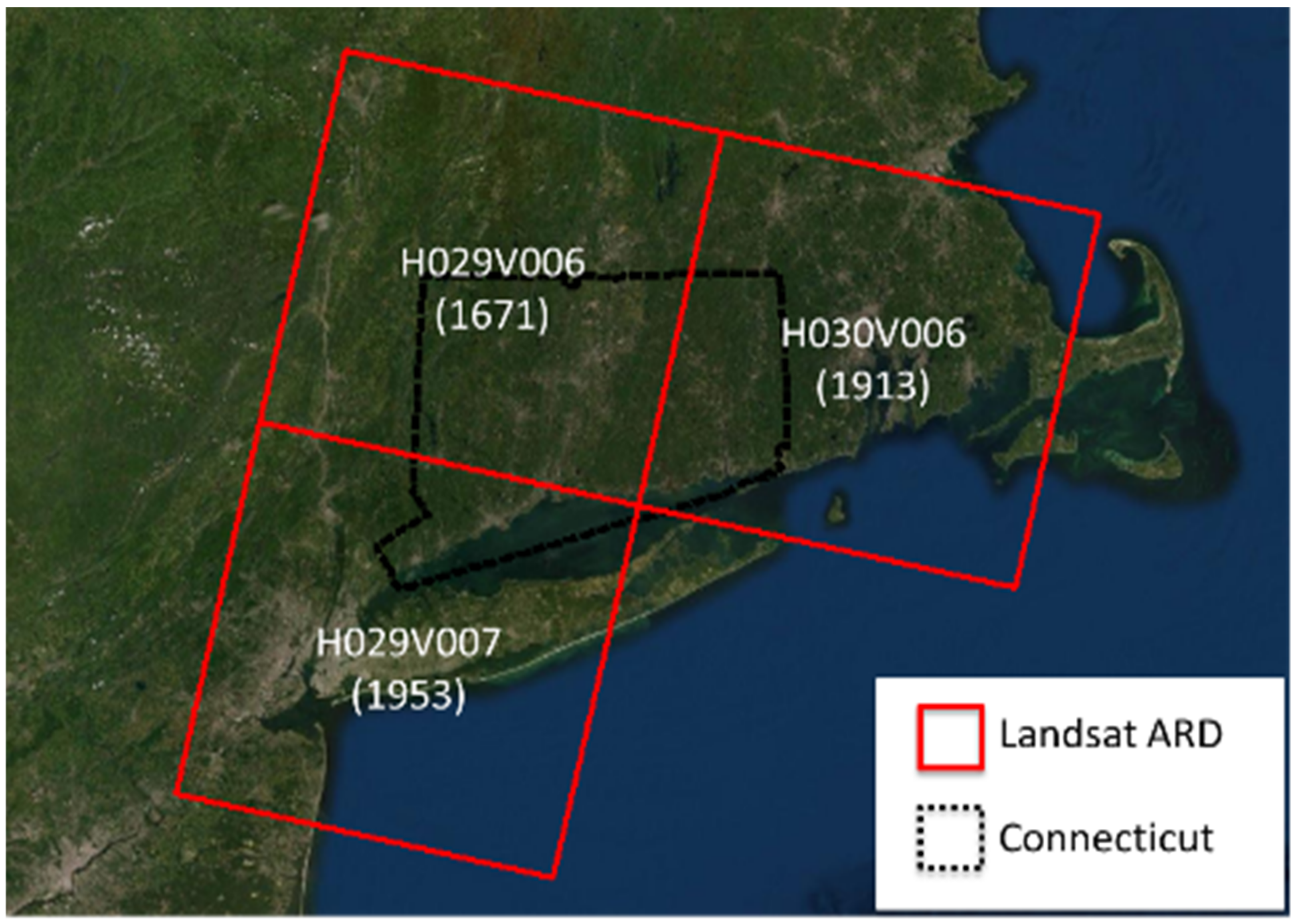
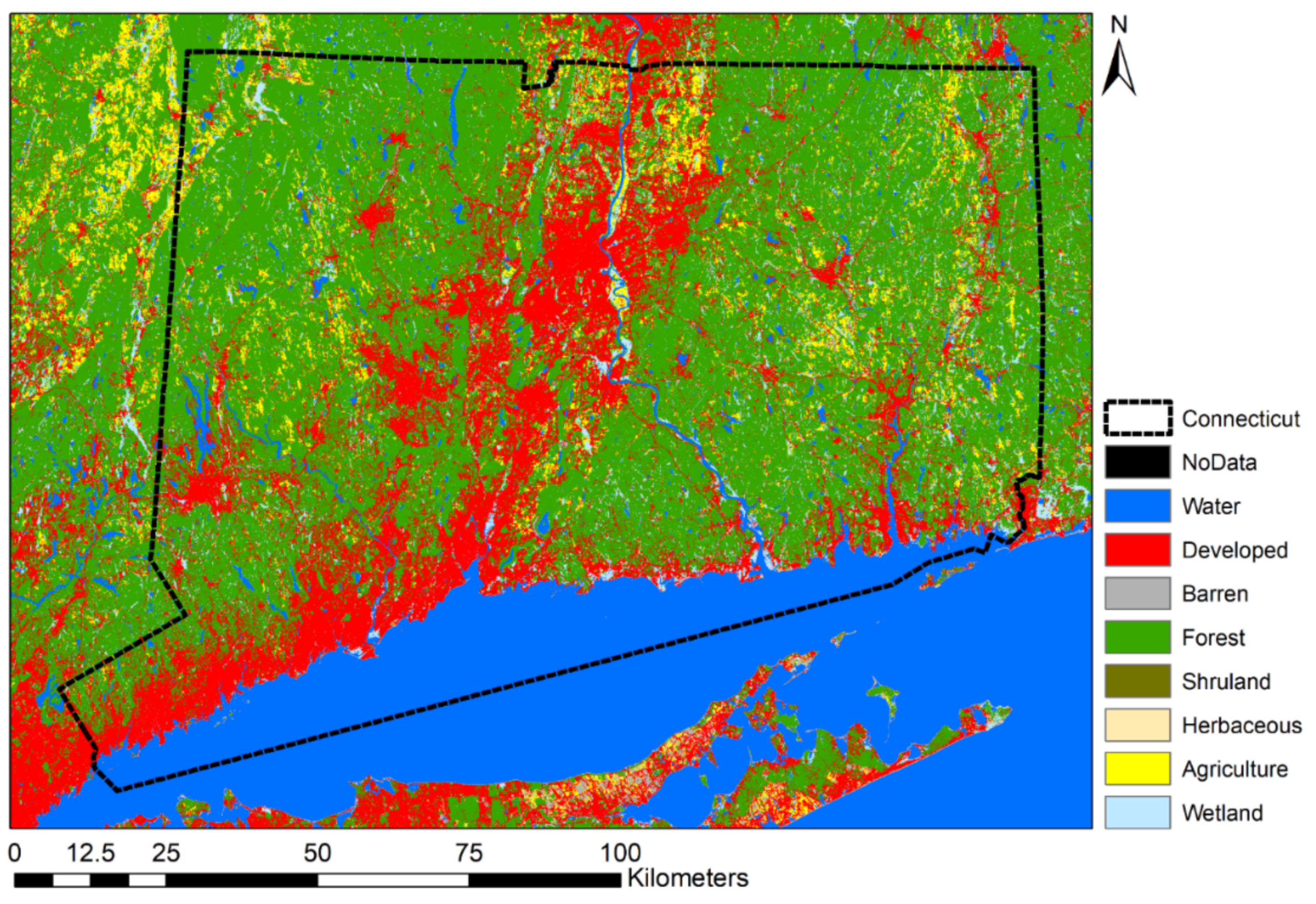
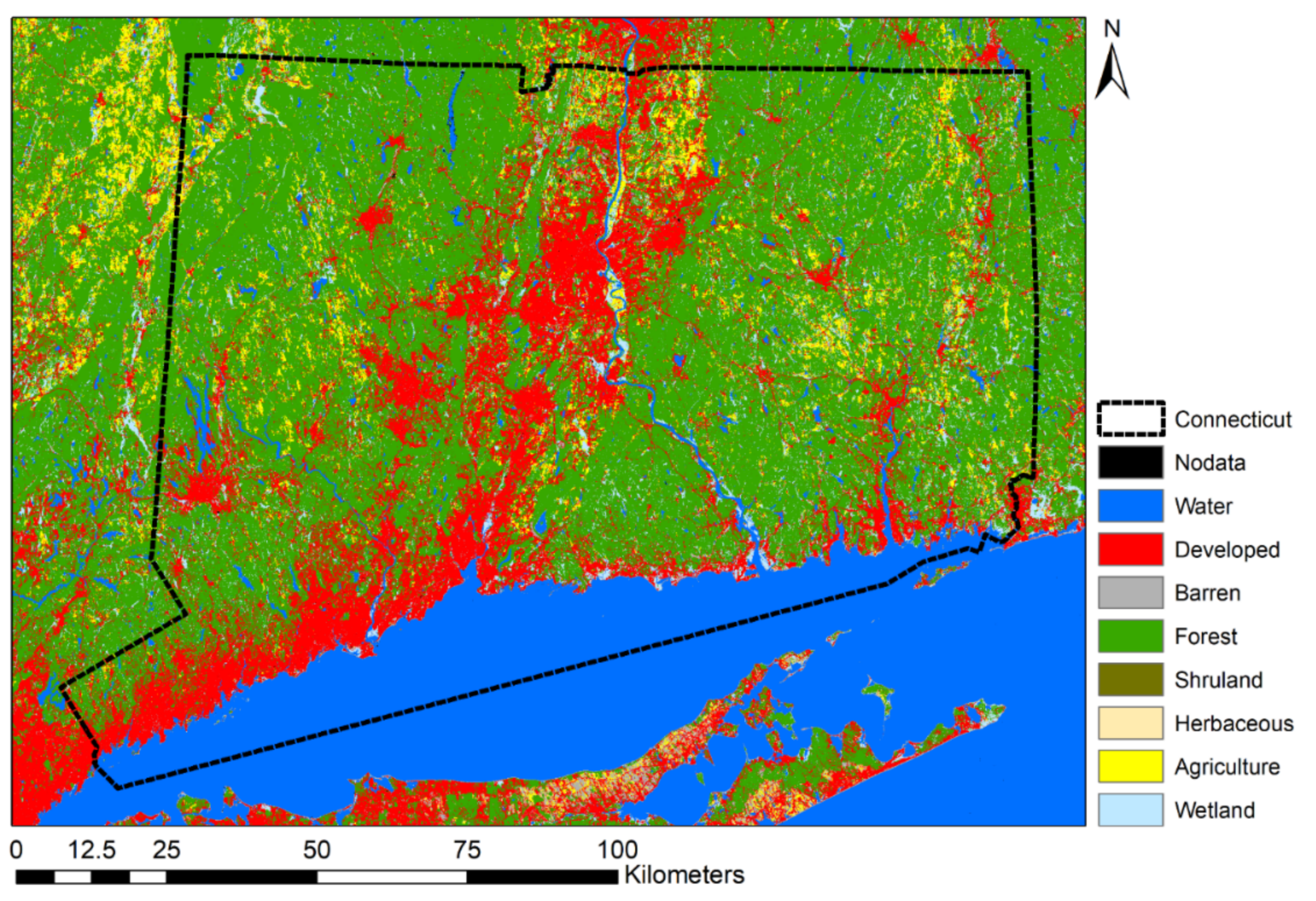
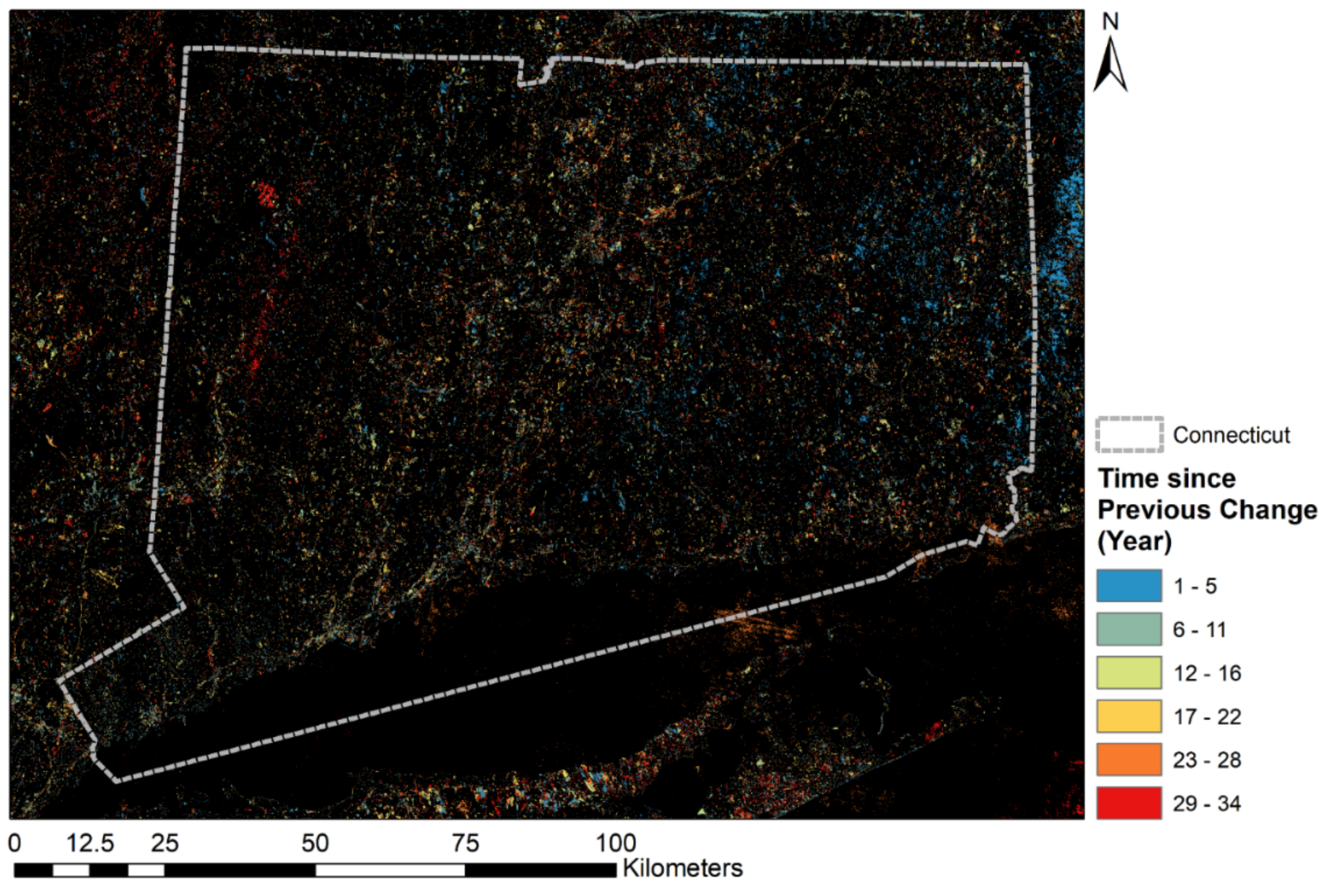
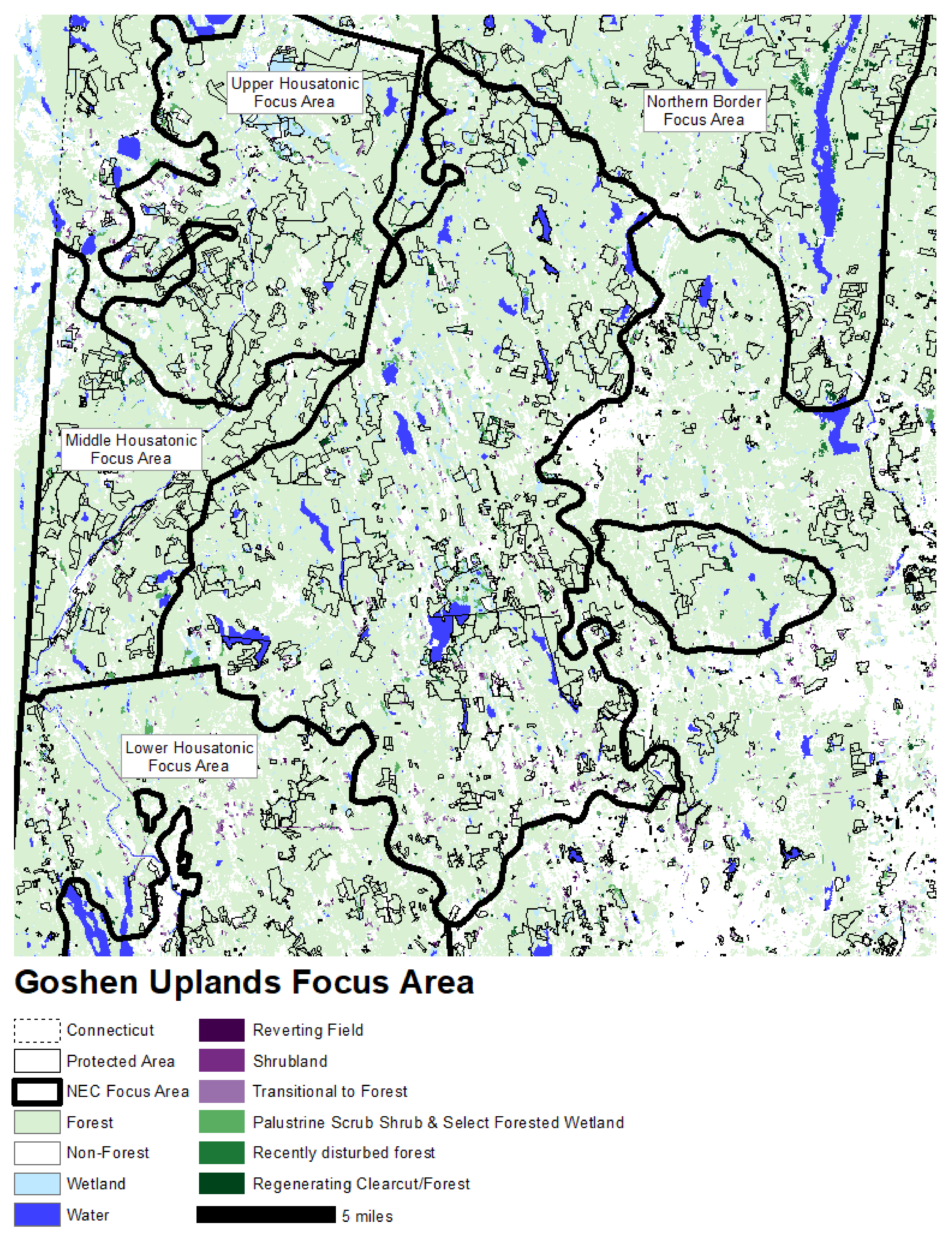
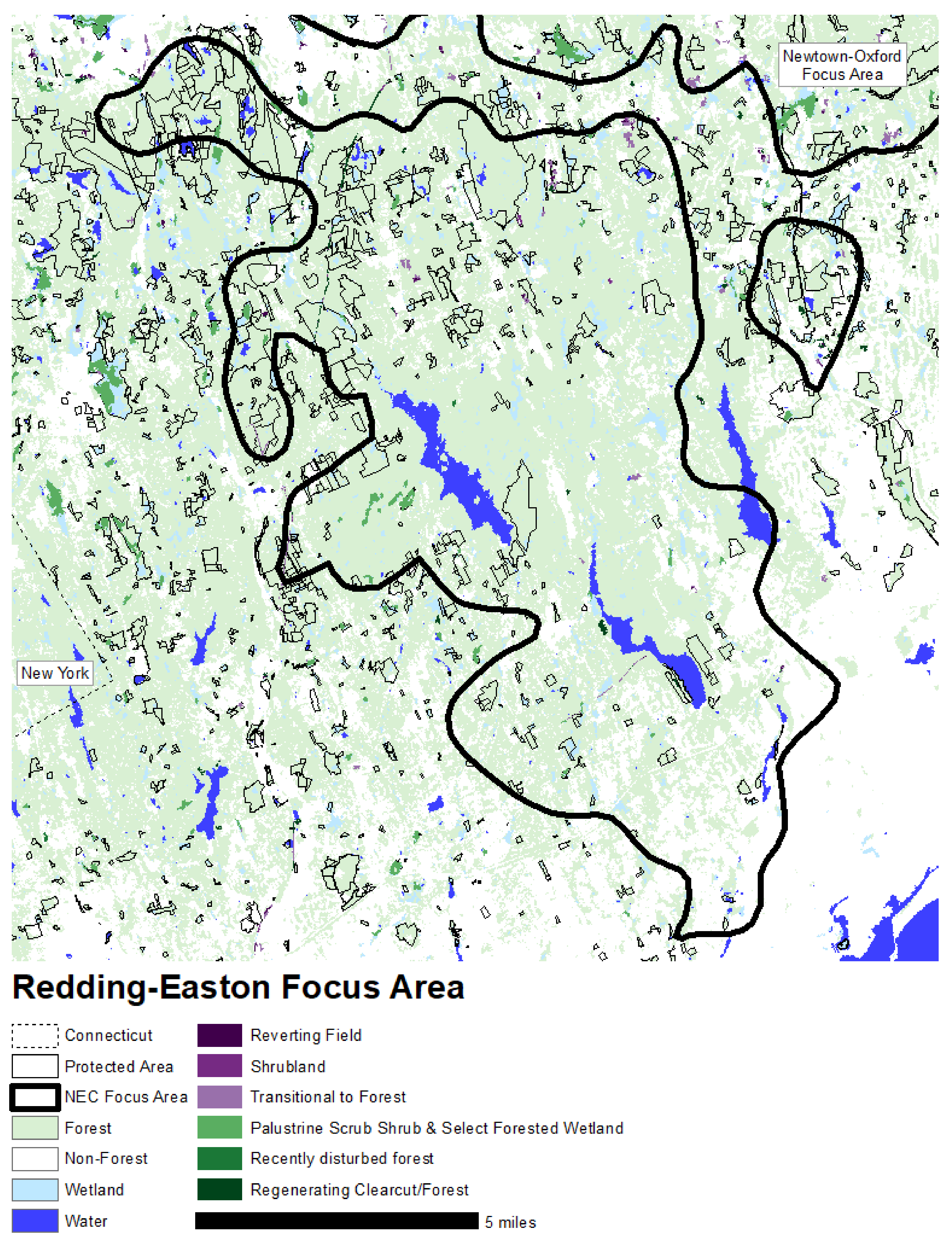
| Process(es) | Vegetation Types | Sub-Types | Previous Land Cover Type | Time Since Disturbance (Years) |
|---|---|---|---|---|
| Succession | Reverting Field | Reverting field Old field | Non-forest | |
| Shrubland | Shrubland | Non-forest | ||
| Transitional to Forest | Reverting field to forest Reverting old field to forest Shrubland to forest Tall shrubland-young forest | Non-forest | ||
| Disturbance and Regeneration | Recently Disturbed Forest | Forest | 0–2 | |
| Regenerating Clearcut | Forest | 3–20 | ||
| Regenerating Forest | Forest | 3–20 | ||
| Arrested Reverting Field | Forest | >20 | ||
| Arrested Shrubland | Forest | >20 | ||
| Hydrology | Palustrine Scrub-Shrub and Forested Wetlands | Listed in Supplemental Table S1 |
| Percent of Vegetation Cover 2.5 to 10 m Tall | Percent of Vegetation Height 0.5 to 2.5 m | ||||
|---|---|---|---|---|---|
| 0 to 10% | 11 to 25% | 26 to 50% | 51 to 75% | 76 to 100% | |
| 1 to 25% | Field | Reverting Field or Old Field | Reverting Field or Old Field | Shrubland | Shrubland |
| 26 to 50% | Tall Shrubland-Young Forest | Tall Shrubland-Young Forest | Reverting Field-to-Forest | Shrubland-to-Forest | Not possible |
| 51 to 75% | Not habitat | Tall Shrubland-Young Forest | Reverting Field-to-Forest or Tall Shrubland-Young Forest | Not possible | Not possible |
| 76 to 100% | Not habitat | Tall Shrubland-Young Forest | Not possible | Not possible | Not possible |
| Map | Verification Method | Reference | ||||||||
|---|---|---|---|---|---|---|---|---|---|---|
| Reverting Field | Shrubland | Transitional to Forest | Recently Disturbed Forest | Regenerating Clearcut | Regenerating Forest | Forest | Non-Forest | Total i | ||
| Reverting Field | Field | 56 | 5 | 9 | 0 | 0 | 0 | 0 | 16 | 86 |
| Shrubland | Field | 9 | 40 | 2 | 0 | 0 | 2 | 0 | 7 | 60 |
| Transitional to Forest | Field | 2 | 5 | 89 | 0 | 0 | 0 | 0 | 10 | 106 |
| Recently Disturbed Forest | Aerial | 1 | 1 | 4 | 75 | 0 | 0 | 15 | 19 | 115 |
| Regenerating Clearcut | Aerial | 1 | 9 | 1 | 0 | 72 | 0 | 0 | 32 | 115 |
| Regenerating Forest | Aerial | 0 | 2 | 13 | 1 | 4 | 71 | 10 | 13 | 114 |
| Forest | Aerial | 1 | 0 | 1 | 0 | 2 | 2 | 350 | 44 | 400 |
| Non-forest | Aerial | 0 | 0 | 3 | 0 | 0 | 3 | 23 | 258 | 287 |
| Total j | 70 | 62 | 122 | 76 | 78 | 78 | 398 | 399 | 1283 | |
| Map | Producer’s Accuracy ± 95% CI | User’s Accuracy ± 95% CI | Adjusted Area ± 95% CI |
|---|---|---|---|
| Reverting Field | 50.3 ± 41.4 | 65.1 ± 10.1 | 4412 ± 3623 |
| Shrubland | 30.2 ± 11.9 | 66.7 ± 12.0 | 1464 ± 552 |
| Transitional to Forest | 55.0 ± 21.3 | 84.0 ± 7.0 | 18,656 ± 7256 |
| Recently Disturbed Forest | 95.4 ± 8.6 | 65.2 ± 8.7 | 986 ± 154 |
| Regenerating Clearcut | 23.1 ± 23.7 | 62.6 ± 8.9 | 5002 ± 5078 |
| Regenerating Forest | 25.8 ± 17.0 | 62.3 ± 8.9 | 12,424 ± 8050 |
| Forest | 93.7 ± 2.3 | 87.5 ± 3.2 | 684,375 ± 29,031 |
| Non-forest | 85.0 ± 3.4 | 89.9 ± 3.5 | 559,278 ± 29,127 |
| Total Area | 1,286,598 ha |
| Focus Area | Reverting Field | Shrubland | Transitional to Forest | Recently Disturbed Forest | Regenerating Clearcut | Regenerating Forest | Palustrine Scrub-Shrub and Forested Wetland | Focus Area Total |
|---|---|---|---|---|---|---|---|---|
| Goshen Uplands | 110 | 65 | 462 | 66 | 120 | 144 | 531 | 1499 |
| Lebanon | 56 | 7 | 119 | 38 | 45 | 53 | 96 | 414 |
| Ledyard-Coast | 59 | 19 | 274 | 97 | 17 | 41 | 219 | 726 |
| Lower Connecticut River | 59 | 9 | 257 | 8 | 34 | 81 | 331 | 781 |
| Lower Housatonic River | 102 | 51 | 391 | 30 | 13 | 59 | 138 | 783 |
| Middle Housatonic | 21 | 8 | 114 | 10 | 31 | 63 | 141 | 388 |
| Newtown-Oxford | 29 | 11 | 133 | 17 | 20 | 57 | 214 | 480 |
| Northern Border | 13 | 3 | 59 | 183 | 93 | 254 | 121 | 726 |
| Pachaug | 76 | 5 | 226 | 32 | 87 | 251 | 154 | 830 |
| Redding-Easton | 8 | 4 | 46 | 0 | 10 | 23 | 87 | 178 |
| Scotland-Canterbury | 47 | 4 | 108 | 67 | 64 | 62 | 113 | 466 |
| Upper Housatonic | 38 | 12 | 199 | 23 | 18 | 69 | 199 | 558 |
| Total ha | 619 | 200 | 2388 | 569 | 550 | 1158 | 2344 | 7827 |
| Vegetation Type | Complex Size (ha) | ||||
|---|---|---|---|---|---|
| 2 to 4 | 4 to 10 | 10 to 20 | 20+ | Total | |
| Reverting Field | 274 | 229 | 93 | 22 | 619 |
| Shrubland | 74 | 78 | 42 | 6 | 200 |
| Transitional to Forest | 903 | 925 | 415 | 144 | 2388 |
| Recently Disturbed Forest | 92 | 172 | 106 | 200 | 569 |
| Regenerating Clearcut | 142 | 166 | 93 | 149 | 550 |
| Regenerating Forest | 315 | 426 | 152 | 265 | 1158 |
| Palustrine Scrub-shrub and Forested Wetland | 634 | 841 | 414 | 455 | 2344 |
| Total ha | 2434 | 2835 | 1316 | 1242 | 7827 |
| Focus Area | Protected Ownership Type | All Protected Lands | Private Lands | Total Lands | Percent Conserved | ||||
|---|---|---|---|---|---|---|---|---|---|
| Federal | State | Local | Private | Other * | |||||
| Goshen Uplands | 0 | 184 | 11 | 25 | 186 | 406 | 1092 | 1499 | 27.1 |
| Lebanon | 0 | 38 | 4 | 7 | 8 | 57 | 357 | 414 | 13.8 |
| Ledyard-Coast | 0 | 170 | 26 | 0 | 8 | 204 | 522 | 726 | 28.1 |
| Lower Connecticut River | 2 | 93 | 47 | 11 | 23 | 178 | 603 | 781 | 22.8 |
| Lower Housatonic River | 0 | 22 | 31 | 0 | 51 | 103 | 680 | 783 | 13.2 |
| Middle Housatonic | 0 | 53 | 1 | 0 | 38 | 93 | 295 | 388 | 23.9 |
| Newtown-Oxford | 0 | 56 | 45 | 3 | 43 | 147 | 332 | 480 | 30.7 |
| Northern Border | 0 | 161 | 0 | 2 | 15 | 179 | 546 | 726 | 24.7 |
| Pachaug | 0 | 247 | 0 | 0 | 5 | 253 | 577 | 830 | 30.4 |
| Redding-Easton | 0 | 4 | 32 | 13 | 13 | 62 | 116 | 178 | 34.9 |
| Scotland-Canterbury | 0 | 54 | 0 | 2 | 0 | 57 | 409 | 466 | 12.2 |
| Upper Housatonic | 0 | 53 | 6 | 29 | 36 | 123 | 434 | 558 | 22.1 |
| Total within Focus Areas | 2 | 1136 | 204 | 93 | 427 | 1864 | 5964 | 7827 | 23.8 |
| Total Statewide | 10 | 2344 | 935 | 141 | 807 | 4236 | 16,716 | 20,953 | 20.2 |
| Vegetation Type | Complex Size (ha) | ||||
|---|---|---|---|---|---|
| 2 to 4 | 4 to 10 | 10 to 20 | 20+ | Total | |
| Reverting Field | 446 | 363 | 161 | 23 | 994 |
| Shrubland | 99 | 93 | 51 | 4 | 246 |
| Transitional to Forest | 1365 | 1240 | 580 | 141 | 3325 |
| Recently Disturbed Forest | 135 | 267 | 164 | 309 | 875 |
| Regenerating Clearcut | 237 | 260 | 141 | 162 | 799 |
| Regenerating Forest | 561 | 725 | 401 | 328 | 2015 |
| Palustrine Scrub-shrub and Forested Wetland | 1082 | 1270 | 609 | 428 | 3389 |
| Total ha | 3925 | 4218 | 2106 | 1395 | 11,644 |
Publisher’s Note: MDPI stays neutral with regard to jurisdictional claims in published maps and institutional affiliations. |
© 2022 by the authors. Licensee MDPI, Basel, Switzerland. This article is an open access article distributed under the terms and conditions of the Creative Commons Attribution (CC BY) license (https://creativecommons.org/licenses/by/4.0/).
Share and Cite
Rittenhouse, C.D.; Berlin, E.H.; Mikle, N.; Qiu, S.; Riordan, D.; Zhu, Z. An Object-Based Approach to Map Young Forest and Shrubland Vegetation Based on Multi-Source Remote Sensing Data. Remote Sens. 2022, 14, 1091. https://doi.org/10.3390/rs14051091
Rittenhouse CD, Berlin EH, Mikle N, Qiu S, Riordan D, Zhu Z. An Object-Based Approach to Map Young Forest and Shrubland Vegetation Based on Multi-Source Remote Sensing Data. Remote Sensing. 2022; 14(5):1091. https://doi.org/10.3390/rs14051091
Chicago/Turabian StyleRittenhouse, Chadwick D., Elana H. Berlin, Nathaniel Mikle, Shi Qiu, Dustin Riordan, and Zhe Zhu. 2022. "An Object-Based Approach to Map Young Forest and Shrubland Vegetation Based on Multi-Source Remote Sensing Data" Remote Sensing 14, no. 5: 1091. https://doi.org/10.3390/rs14051091
APA StyleRittenhouse, C. D., Berlin, E. H., Mikle, N., Qiu, S., Riordan, D., & Zhu, Z. (2022). An Object-Based Approach to Map Young Forest and Shrubland Vegetation Based on Multi-Source Remote Sensing Data. Remote Sensing, 14(5), 1091. https://doi.org/10.3390/rs14051091







